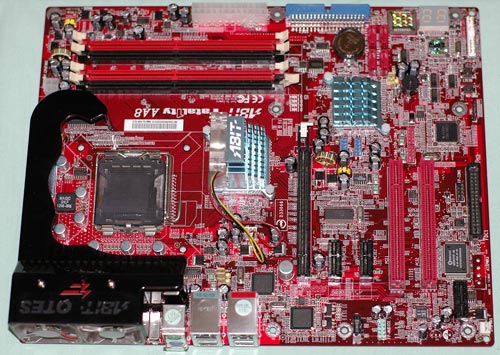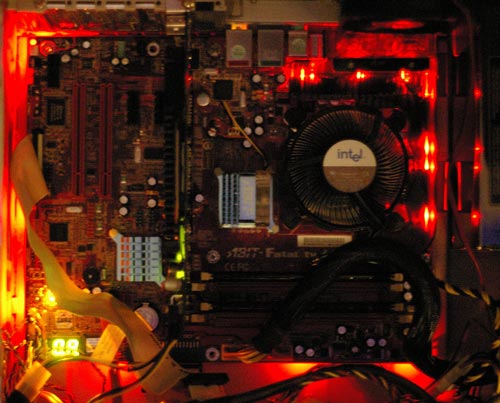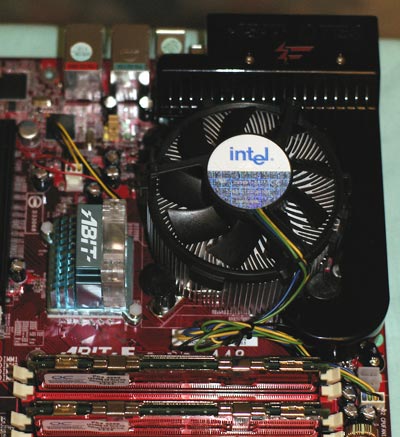FIRST LOOK: Abit Fatal1ty AA8XE
by Wesley Fink on November 9, 2004 8:30 AM EST- Posted in
- Motherboards
Features and Overclocking
| Abit Fatal1ty AA8XE Motherboard Specifications | |
| CPU Interface | Socket 775 Pentium 4 (Prescott) |
| Chipset | Intel 925XE/ICH6R |
| Bus Speeds | 200MHz to 400MHz (in 1MHz steps) |
| DDR2 Speeds | Auto, 400, 533 |
| N/B Strap | By CPU, PSB533, PSB800, PSB1066 |
| PCI Express Speeds | 99MHz to 255MHz (in 1MHz intervals) |
| PCI Speeds | 33.33, 36.36, 40.00 |
| Core Voltage | CPU Default (1.575V) to 1.925V in 0.025V increments |
| FSB VTT Voltage | 1.0V to 1.8V in .05V steps |
| DRAM Voltage | 1.6V to 2.55V in 0.05V increments |
| DDR VTT Voltage | 0.8V to 1.8V in .05V increments |
| Northbridge Voltage | 1.3V to 2.1V in 005V increments |
| NB 2.5V | 2.3V to 3.0V in .05V steps |
| Memory Slots | Four 184-pin DDR2-533/400 Slots Dual-Channel Unbuffered DDR2 to 4GB |
| Expansion Slots | 1 PCIe x16 slot 2 PCIe x1 slots 2 PCI slots Dedicated Audio Daughter Card slot |
| Onboard SATA/RAID | 4 SATA 150 drives by ICH6R Intel Matrix Raid 0,1 |
| Onboard IDE | One ATA100/66 (ICH6) - 2 Drives |
| Onboard USB 2.0 | 8 USB 2.0 ports |
| Onboard Firewire | 3 IEEE1394A FireWire Ports by TI 43CR30T |
| Onboard LAN | Dual Intel Ethernet - Gigabit + 10/100 |
| Onboard Audio | High Definition Realtek ALC880D 8-Channel HD, Dolby Digital Live AudioMAX connectors for reduced noise |
| Tested BIOS | M408_10.B07 10/15/2004 |

The Abit Fatal1ty AA8XE was designed for top gaming performance and overclocking. This is reflected in the very complete selection of tweaking controls and the extended adjustment ranges. The BIOS controls with wide adjustment ranges will allow overclockers to push the Fatal1ty to wherever the processor can go.
One surprise was the lack of a higher DDR2 ram speed option in a board designed for performance. The 925XE Asus P5AD2-E, for example, has a speed option of DDR2 710 in BIOS.
The feature set is basic 915X/925XE without the additional features often seen on top-of-the-line Socket 775 motherboards. This means that the ports and options are those provided by the 925X/925XE chipset. This may not be a bad thing where stability is the primary goal, but the Fatal1ty really adds very little to the standard 925X/925XE feature set. There are provisions for Firewire and enhancements for noise reduction on the excellent Intel High Definition 8-channel audio, but you will be hard pressed to find any other new features on Fatal1ty. As with other 925X/XE boards there are provisions for just 2 IDE devices, which may be an issue if your gaming needs include several optical drives or IDE hard drives.

Sometimes gaming is as much about appearances as substance, and there is no doubt that Abit understands this. The Fatal1ty is back-lit with red LEDs, which will make the Fatal1ty stand out in any side window case.

Abit also concentrates on cooling with the AA8XE. You can see the shroud for the dual OTES cooling for the power transistors. It is carefully designed, so there is no issue with mounting a standard Intel Socket 775 cooling fan. However, if you plan to use a large custom heatsink, you are likely out of luck.
Overclocking
The Fatal1ty is designed for top performance, and top performance normally includes overclocking. We were extremely pleased to reach a stable 323x12 with our test 3.46EE. 12X is the lowest ratio available on this partially unlocked EE chip. This is a CPU speed of 3876MHZ at a bus speed of 1292. Apparently, this is the limit on air with modest voltage increases for this processor, since the stock 13X multiplier would only reach 299x13 - approximately the same speed.With water cooling or phase-change cooling, the Abit Fatal1ty would likely take this chip further, since heat was becoming a large problem with this Gallatin core CPU at nearly 3.9GHz speed. 323x12 is an outstanding overclock, but this needs to be kept in perspective. The starting point for the 3.46EE is 266, so the reach to 323 is just a 21% overclock of the FSB at the lower multiplier. If we consider the CPU is running at 3876MHz, the overclock is only 12% compared to the rated CPU speed.
Prescott core 800FSB processors will also work fine on the Abit Fatal1ty. We did a brief test with an unlocked 560 Prescott and managed to reach a stable 284x14, or a speed of about 4GHz on air. The FSB limitation here is likely the result of the 14 multiplier, which is the lowest available on the unlocked 3.6GHz processor. If lower ratios were available, it is likely that the Abit Fatal1ty could take you to the highest FSB the CPU could reach.










46 Comments
View All Comments
Badash7 - Monday, November 22, 2004 - link
Does it have or will it have through a bios update support for ddr2 667mhz or faster memory like the asus 925xe p5ad2-e does?jonmcc33 - Saturday, November 13, 2004 - link
The "real" Jonathan Wendel is uncovered!http://www.eeob.iastate.edu/faculty/WendelJ/jonath...
jonmcc33 - Saturday, November 13, 2004 - link
Number 1 in talentless games like Quake 3 and Unreal Tournament and that makes him respected? A 5 year old could play those games.Maybe if he played Call of Duty or something else that requires skill then I'd think he deserves a motherboard named after him.
knitecrow - Friday, November 12, 2004 - link
those numbers don't matter for this boardthis board is targeted towards hard core gammers... who are slightly smarter than the average dell buyer.
the break down between AMD and Intel is very different for the performance gamming market. My guess is 60-40 (amd:intel)
Even Intel fanboyz are being persuaded by hard facts... for gamming Athlon64 is king.
OzMowerman - Friday, November 12, 2004 - link
AMDx86: 14.9%
notebook: 8.4%
server: 4.8%
Intel
x86: 83.6%
notebook: 90.1%
server: 96.9%
"a flea in the crack of an elephants arse" is the only thing that springs to mind
Its not hard to see why the amd fanboys get upset....LOL
when it comes to the end of the day, they make crap products and are untrustworthy.
Isnt it funny that its always the tight arse low income that sprulk amd the hardest.
If Intel made a chipset for amd processors, i would seriously consider buying one, but while our only choice is the backyarders via, and the incompetant nvidia, no thanks.
cryptonomicon - Thursday, November 11, 2004 - link
sorry, hard to resist flaming this board for some reason.cryptonomicon - Thursday, November 11, 2004 - link
so this board is really killer at.. uh.. what? media encoding and workstation performance? drool!Concillian - Wednesday, November 10, 2004 - link
#36:If those gamers are only overclocking the video card and do not overclock the CPU, they are potentially doing the right thing. What game fully utilizes an FX55 at the resolutions people actually use?
Games in general are not CPU bound at this point, so why fret over 5% here and there if the video card is going to limit your frame rates anyway? Get what's cheap for CPU and pimp out on the graphics card.
It would be nice to eventually see a review that exhibits just how GPU limited most games are even with the highest end GPUs. We always see CPU articls with the highest end GPUs to try to remove that side fo the equation and vice versa. But for a consumer they often have to take their budget and decide what gets spent where between CPU, RAM, and video cards. Probably the single most common decisions among gamers focus on these types of decisions, yet there are surprisingly few articles that focus on how to approch realistic purchasing decisions for these three critical components.
vailr - Wednesday, November 10, 2004 - link
#25: A serial port can be added to any USB port, using a USB-to-serial port adapter.$14.99 here: http://www.svc.com/usbsead.html
Wesley Fink - Wednesday, November 10, 2004 - link
#35 - My experience has been that ENTHUSIASTS know about water and phase-change cooling, but gamers usually don't know much about overclocking systems. If they overclock anything it's the video card. There are exceptions to every rule, but this is a GAMING system and I think our comments are apropos.If you believe the FX55 (2.6GHz) are not overclockable, you are not reading many articles. Most are reaching 2.9Ghz to 3.OGhz at stock voltage with air cooling. Those using water and phase-change are getting much higher results. The 90nm die-shrink will likely open the high-end even more for A64.